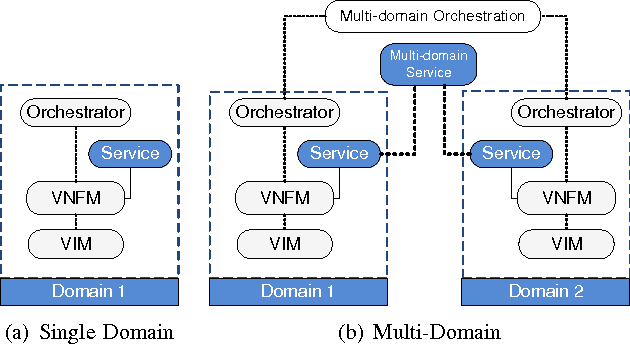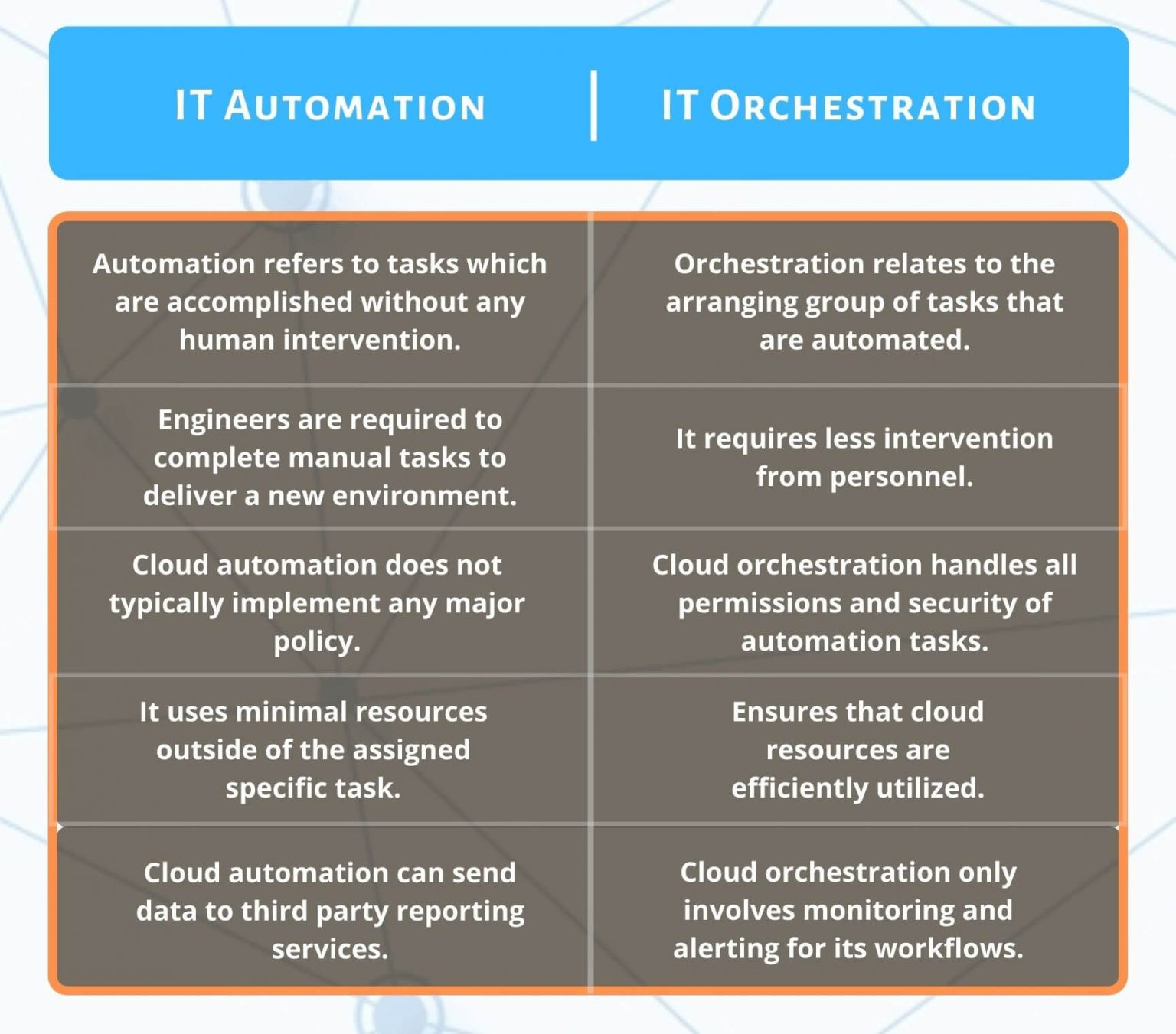Telcos have now started prioritizing automation; there are several factors responsible for this. Companies continuously commoditize traditional resources and use agile concepts to become more competitive. Moreover, digital services have increased network demand. All these reasons have caused telecom players to be more efficient using automated services. They are trying to find a common closed-loop, automated, and cloud-native platform. However, their existing business is disorganized, and they must deal with the complexity of software-defined networks (SDN) and network functions virtualization (NFV).

Fig 1: Single and multi-domain orchestration for NFV
Image credit: semanticscholar.org
Domain orchestration manages this complexity by merging other technologies with the traditional service and network management silos. These technologies include OSS capabilities, network orchestration, and SDN-based management and control. Using this technique, operators can slowly build an end-to-end automated network. They only have to define domains and automate them one by one according to their needs.
Domain orchestration allows operators to reduce costs and increase agility if they build it on an open platform. This method allows them to reuse platform components and converge each automated domain onto a single automation platform.
So we need to approach it in phases. For example, automate specific domains and slowly progress in coordinated incremental steps. Finally, we can create an efficient DNOP or Digital Network and Operations Platform. This technique is the essence of implementing a domain orchestrator. RAN domain orchestration enables CSPs to automate by prioritizing high-value areas.
Contents
- 1 What is the difference between Orchestration and Automation?
- 2 Single Vs multi-domain orchestration
- 3 Domain orchestrator: an evolutionary approach for hybrid network automation
- 4 Non-real-time RAN Intelligent Controller
- 5 Benefits of RAN domain orchestration
- 6 Best practices for implementing a domain orchestrator
- 7 Things to consider as domain orchestration evolves
- 8 Conclusion
- 9 FAQs
What is the difference between Orchestration and Automation?

Fig 2: Key differences between automation and orchestration
Image credit: hitechnectar.com
Orchestration and Automation have similar meanings; however, they are slightly different. Automation refers to something that doesn’t need human intervention. It refers to a single task. However, orchestration refers to organizing such automated tasks in the proper order.
In orchestration, we try to streamline automated tasks in complex systems. It could be on-premise or cloud; we use orchestration to support larger workflows, like a Telecom Operator’s network.
Single Vs multi-domain orchestration
Orchestration can be within a domain or across several domains. The direction in which data travels differs in both types of orchestration, making single-domain orchestration pretty straightforward. In single-domain orchestration, we only have to deal with the north-south data flow.
However, we must also consider the east-west data flow in multi-domain orchestration or orchestrating across the domains. These include inventory systems, order systems, ticketing systems, etc.
Another difference is in the mode of thinking; we need to consider the available models while orchestrating across the domains. While orchestrating within the domain, we don’t have to do so. We only have to consider the server availability in a single-domain orchestration; in multi-domain orchestration, we also have to focus on service availability. That means we must consider what will affect the service availability and the orchestration speed.
Additionally, as the scale of multi-domain orchestration increases, the dependencies also increase. This increase will also affect service availability, which we must consider while planning the orchestration.
Domain orchestrator: an evolutionary approach for hybrid network automation
We can’t achieve end-to-end automation in hybrid networks immediately; we need to consider the significance of the technological and operational change. However, each operator defines domain orchestration in a slightly different way. But all of them strive to combine management and control components. All of them want NFV, SDN, and traditional network operations that are:
- Unified
- Self-sufficient
What are domains?
A domain is a logical structure on which a CSP will apply automation. Examples of domains include a customer-facing service (VPN, VoLTE, etc.), a networking layer (IP/MPLS, etc.), and a location.
What is a domain orchestrator?
A domain orchestrator is responsible for the life cycle of a domain, including activation, fault, configuration, accounting, performance, security, and quality management. These domain orchestrators (DOs) can be in a hierarchy; some DOs have a higher level than others, making automation structured. This means we can program each DO independently. For example, we can program DOs on the lower level to abstract complexities from the upper layer.
Properties of an orchestration environment:
- Merging traditional and new lifecycle management
- Using existing management tools to support legacy services
- Ability to manage virtual networks, including SDNs, VNFs, and Virtualized Infrastructure Management (VIM)
- Consisting of standard APIs on an open platform to ensure reusability and multi-vendor DO support
Non-real-time RAN Intelligent Controller
Also called Non-RT RIC, this component of RAN architecture plays a vital role in Ran domain orchestration. Non-RT RIC resides in the SMO layer and uses outside data to optimize RAN and near-RT RIC using set policies and AI/ML technology.
Benefits of RAN domain orchestration
Using a domain orchestrator:
- Operators can define and prioritize domains based on business objectives. This will provide a clear picture of where to start automation. Operators can ensure that high-value domains get automated first and that all the domains remain interoperable using open interfaces.
- We can ensure real-time automation in geographically distributed networks as the orchestration and management can be close to the service components.
- RAN Domain orchestration will introduce streamlined, optimized, and autonomous domains that reduce complexity. Moreover, it increases reliability as it eliminates a single point of failure.
Best practices for implementing a domain orchestrator
- Create and prioritize domains based on the infrastructure of your organization.
- Start by automating one domain, then move on to the next.
- Ensure a maximum commonality among the domains. However, we may need to add specific functions. This practice will avoid recreation and ensure maximum reusability.
- RAN domain orchestration components must consist of cloud-native microservices that we can reuse, modify, and implement in other domains. The cloud-native architecture enables automated management of the lifecycle of domains.
- Ensure a DevOps design platform while creating the microservices for domain orchestrators.
- The microservices should be able to support legacy services.
- Use a model-driven approach to minimize errors and maximize programmability. This includes data models, templates, and modelling languages.
- Use open and service intent APIs to ensure maximum support with vendors and maximize the capability of a Domain Orchestrator.
- Build the Domain Orchestration Platform using shared middleware to expose commonality across domains. You can use PaaS for this shared middleware to avoid unnecessary and complex middleware components and faster software development.

Fig 3: Intent-based designing and orchestration
Image credit: ericsson.com
Things to consider as domain orchestration evolves
Introduction of Open and Cloud RAN means we need to consider certain points in RAN management and orchestration:
- AI will be crucial in all aspects of orchestration, including traffic steering and optimisation decisions for an efficient network.
- RAN management and orchestration will be crucial for properly implementing 5G and harnessing its benefits, including low latency and high bandwidth.
- The orchestration systems will be necessary for the distributed virtualized core and radio. These components will be on multiple data centres and the edge close to the end-user.
Conclusion
Automation has become necessary in the telecom industry because of the increased complexity of telecom networks. A few reasons for the complexity include the use of virtual networks, increased networking demands, and new technologies (edge computing, 5G, IoT, etc.). However, because the existing business uses multiple technologies and vendors, automation has become tedious; this is where Domain Orchestration proves useful. It involves creating several organizational domains based on business objectives, infrastructure, etc. Then automating them in a prioritized manner. For example, we want to automate the domain that produces the largest value.
This domain-based approach has several benefits, including reduced complexity, increased reliability, and programmability. However, ensure that you start automating a single domain while implementing the domain orchestrator and as you progress, ensure that you automate all domains based on some commonality to avoid the re-creation of elements. Slowly, we will be able to create a unified, end-to-end automated, cloud-native platform.
To know more about STL’s Network Modernization Solutions, click here.
FAQs
1. What is domain orchestration and how does it help telecom operators?
Domain orchestration eases the complexities associated with SDN and network function virtualization. It does the needful by merging other associated technologies with the traditional network management and service silos. The telecom providers orchestrate & automate the various operations at a single time through domains. Hence, it helps them reduce the overall costs and boost their agility.
2. What is the difference between Orchestration and Automation?
Orchestration is the approach of coordinating tasks or integrating systems. It makes decisions with reference to the specified outputs, and adapts seamlessly to the change in conditions. The primary goal of orchestration is to keep a tab on all of the automation technologies within the enterprise.
Automation, on the other hand, is the subset of orchestration. It is used by organizations to increase operational efficiency, maximize productive outputs and reduce overall costs. Orchestrations give an enterprise the control and visibility over all automations to achieve overall digital productivity.
3. What is the difference between single-domain and multi-domain orchestration?
For single-domain orchestration, the technicians will have to handle the data flow associated with north to south. But, in terms of multi-domain orchestration, the east to west data flow is also considered, across all domains.
Apart from that, in single-domain orchestration, you need to look just after the server availability, whereas for multi-domain, you need to take the service availability aspects into consideration as well.
4. What are domains in the context of domain orchestration?
Domain orchestration is more like a step-by-step process of evolution, which enables the service providers to streamline various operations as one. Thus, the domains under this approach are categorized as network layers, location and specific services.
5. What is the Non-real-time RAN Intelligent Controller, and what is its role in RAN domain orchestration?
A non real-time RIC (RAN Intelligent Controller) is a specific element of the ORAN architecture. The purpose of it is to optimize and control other RAN resources and elements. It uses the AI and ML techniques for ensuring better control over the RAN resources .














